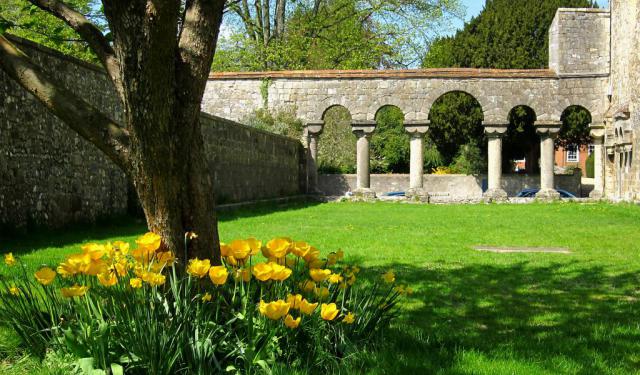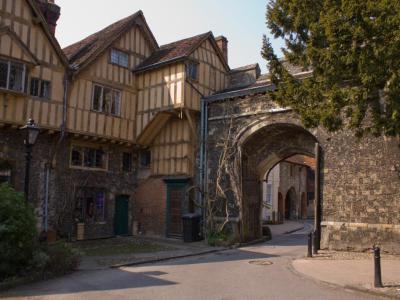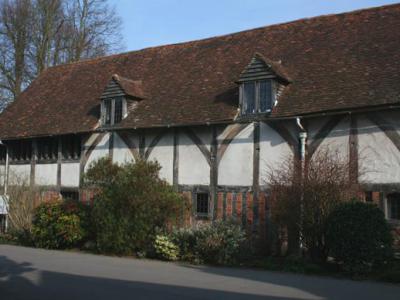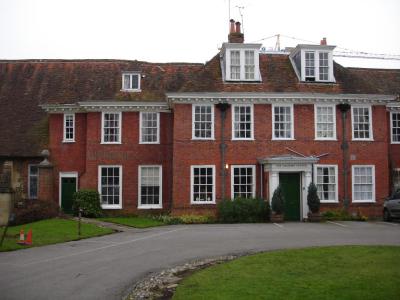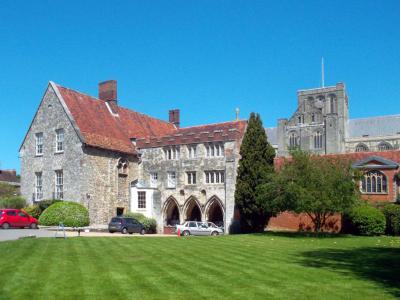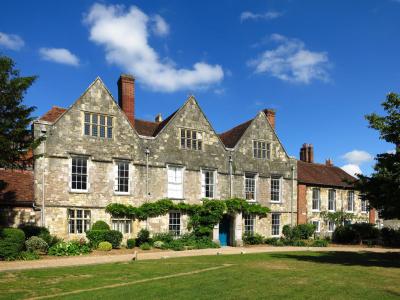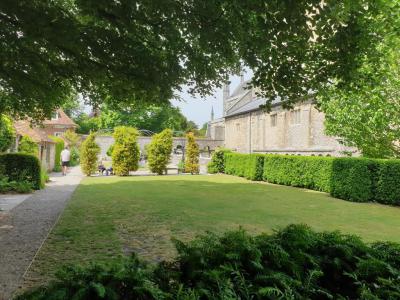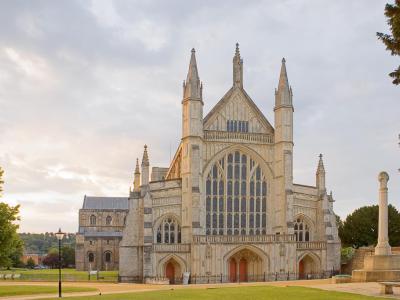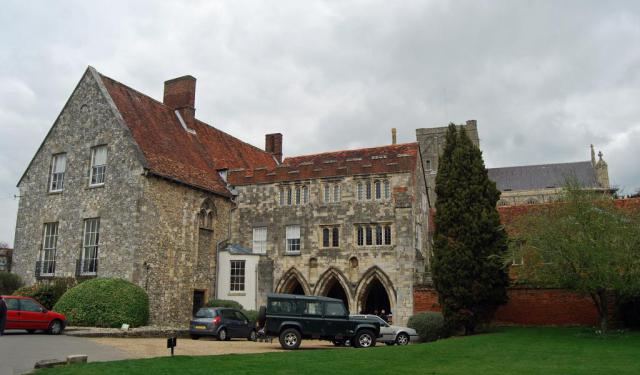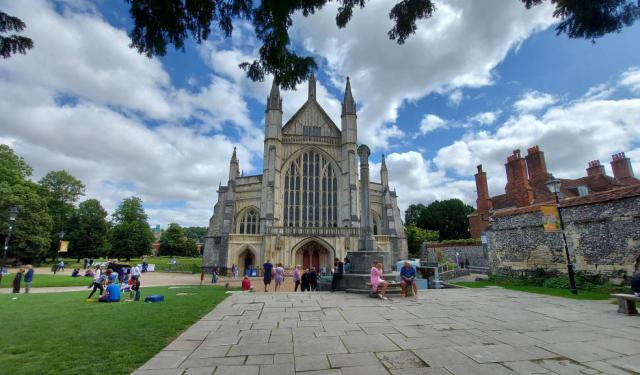Winchester Cathedral Close Walk (Self Guided), Winchester
Winchester Cathedral, originally built in 1079, is the longest Gothic cathedral in Europe. It contains much fine architecture spanning the 11th to the 16th centuries and is the place of interment of numerous Bishops of Winchester (such as William of Wykeham), Anglo-Saxon monarchs (such as Egbert of Wessex), and later monarchs such as King Canute and William Rufus. It was once an important pilgrimage centre and housed the shrine of Saint Swithun.
Winchester Cathedral Close contains a number of historic buildings from the time when the cathedral was also a priory. Of particular note here is the Deanery, which dates back to the 13th century. It was originally the Prior's House and was the birthplace of Arthur, Prince of Wales, in 1486. Not far away is Cheyney Court, a mid-15th-century timber-framed house incorporating the Porter's Lodge for the Prior's Gate. It was the Bishop's courthouse.
The Pilgrims Hall is another notable landmark in the Close. This magnificent medieval hall has stood the test of time and today is often used for various events and gatherings.
Adjacent to the hall, you will find The Pilgrim's School, an institution with a long history of providing education to young minds.
9 The Close is a lovely house that embodies the historical charm of the Close. It is a testament to the residential aspect of this area, where people live amidst centuries of history.
Dean Garnier Garden is a serene and picturesque garden where you can take a stroll and enjoy the beauty of nature amidst the historic surroundings.
And, of course, Winchester Cathedral itself stands as the centerpiece of the Close. This stunning medieval temple is an architectural marvel and a place of worship that has been a focal point of the community for centuries.
Visiting Winchester Cathedral Close allows you to immerse yourself in the culture of England – explore its ancient architecture, enjoy the tranquility of gardens, and soak in the atmosphere of the times long gone. In this remarkable place, history comes to life and you can discover the beauty and significance of Winchester Cathedral Close for yourself. A tremendous opportunity to connect with the past and create lasting memories in a truly extraordinary setting!
Winchester Cathedral Close contains a number of historic buildings from the time when the cathedral was also a priory. Of particular note here is the Deanery, which dates back to the 13th century. It was originally the Prior's House and was the birthplace of Arthur, Prince of Wales, in 1486. Not far away is Cheyney Court, a mid-15th-century timber-framed house incorporating the Porter's Lodge for the Prior's Gate. It was the Bishop's courthouse.
The Pilgrims Hall is another notable landmark in the Close. This magnificent medieval hall has stood the test of time and today is often used for various events and gatherings.
Adjacent to the hall, you will find The Pilgrim's School, an institution with a long history of providing education to young minds.
9 The Close is a lovely house that embodies the historical charm of the Close. It is a testament to the residential aspect of this area, where people live amidst centuries of history.
Dean Garnier Garden is a serene and picturesque garden where you can take a stroll and enjoy the beauty of nature amidst the historic surroundings.
And, of course, Winchester Cathedral itself stands as the centerpiece of the Close. This stunning medieval temple is an architectural marvel and a place of worship that has been a focal point of the community for centuries.
Visiting Winchester Cathedral Close allows you to immerse yourself in the culture of England – explore its ancient architecture, enjoy the tranquility of gardens, and soak in the atmosphere of the times long gone. In this remarkable place, history comes to life and you can discover the beauty and significance of Winchester Cathedral Close for yourself. A tremendous opportunity to connect with the past and create lasting memories in a truly extraordinary setting!
How it works: Download the app "GPSmyCity: Walks in 1K+ Cities" from Apple App Store or Google Play Store to your mobile phone or tablet. The app turns your mobile device into a personal tour guide and its built-in GPS navigation functions guide you from one tour stop to next. The app works offline, so no data plan is needed when traveling abroad.
Winchester Cathedral Close Walk Map
Guide Name: Winchester Cathedral Close Walk
Guide Location: England » Winchester (See other walking tours in Winchester)
Guide Type: Self-guided Walking Tour (Sightseeing)
# of Attractions: 7
Tour Duration: 1 Hour(s)
Travel Distance: 0.8 Km or 0.5 Miles
Author: DanaOffice
Sight(s) Featured in This Guide:
Guide Location: England » Winchester (See other walking tours in Winchester)
Guide Type: Self-guided Walking Tour (Sightseeing)
# of Attractions: 7
Tour Duration: 1 Hour(s)
Travel Distance: 0.8 Km or 0.5 Miles
Author: DanaOffice
Sight(s) Featured in This Guide:
- Prior’s Gate and Cheyney Court
- The Pilgrims Hall
- The Pilgrim’s School
- The Deanery and Prior's Hall
- 9 The Close
- Dean Garnier Garden
- Winchester Cathedral
1) Prior’s Gate and Cheyney Court
Prior’s Gate and Cheyney Court, significant landmarks within Winchester's Close, offer a captivating glimpse into the city's architectural heritage.
Dating back to the 15th century, Prior’s Gate stands as the primary entrance to the Close, characterized by a simple yet elegant four-centred arch, original tracery-adorned doors, and a castellated parapet. The arch proudly displays a coat of arms, adding a regal touch to the structure.
Nearby, Cheyney Court, also hailing from the 15th century, served as the Bishop’s Court House and has earned a reputation as one of Winchester's most photographed residential buildings. The ground floor features sturdy stone construction, while the upper level showcases an overhanging timber frame adorned with three gables filled in with plaster.
Integral to Cheyney Court is the Close wall, seamlessly blending with the structure's rear. Additionally, the 15th-century Porter’s Lodge, a two-story gabled section of the Court block, shares design elements with Cheyney Court. Historically, both the Lodge and Priory Gate were adorned with lush wisteria, creating a spectacular summer display that added to the charm of this architectural ensemble in Winchester's historic Close.
Dating back to the 15th century, Prior’s Gate stands as the primary entrance to the Close, characterized by a simple yet elegant four-centred arch, original tracery-adorned doors, and a castellated parapet. The arch proudly displays a coat of arms, adding a regal touch to the structure.
Nearby, Cheyney Court, also hailing from the 15th century, served as the Bishop’s Court House and has earned a reputation as one of Winchester's most photographed residential buildings. The ground floor features sturdy stone construction, while the upper level showcases an overhanging timber frame adorned with three gables filled in with plaster.
Integral to Cheyney Court is the Close wall, seamlessly blending with the structure's rear. Additionally, the 15th-century Porter’s Lodge, a two-story gabled section of the Court block, shares design elements with Cheyney Court. Historically, both the Lodge and Priory Gate were adorned with lush wisteria, creating a spectacular summer display that added to the charm of this architectural ensemble in Winchester's historic Close.
2) The Pilgrims Hall
The Pilgrims Hall, a venerable structure dating back to approximately 1308, stands as the lone surviving fragment of a once-expansive medieval building that functioned as the priory guest house. This historic half-timbered hall is distinguished by its remarkable hammer beam roof, considered one of the earliest examples of this architectural feature. The beams' terminations are adorned with intricately carved heads, adding a touch of artistry to the structural design.
The exterior showcases a distinctive architectural style with close studding and brick infill below the rail, while large framing and arch braces above it contribute to its overall charm.
Despite undergoing modifications over time, including the addition of floors, modern windows, and a revised entrance, the Pilgrims Hall remains accessible to the public. Notably, the Priors Hall, seamlessly integrated into the contemporary Deanery, underwent substantial rebuilding during the 17th century, further enriching the historical tapestry of this Winchester landmark.
The exterior showcases a distinctive architectural style with close studding and brick infill below the rail, while large framing and arch braces above it contribute to its overall charm.
Despite undergoing modifications over time, including the addition of floors, modern windows, and a revised entrance, the Pilgrims Hall remains accessible to the public. Notably, the Priors Hall, seamlessly integrated into the contemporary Deanery, underwent substantial rebuilding during the 17th century, further enriching the historical tapestry of this Winchester landmark.
3) The Pilgrim’s School
The Pilgrims' School, situated in the cathedral close, stands as a distinguished boys' preparatory and cathedral school. While the official founding date remains unknown, historical records hint at the education of choristers from Winchester Cathedral's renowned choir as early as the 7th century. The school, as it exists today, was inaugurated in 1931, maintaining strong ties with the Winchester College Chapel Choir. With roots dating back to Saxon times, the school's history intertwines with the educational legacy of Winchester Cathedral's choir boys.
In 1931, the school transitioned to its current location, housed in a building redesigned by the eminent Sir Christopher Wren in the 17th century. This location, atop a former Roman villa, incorporates a medieval hall and barn, with the school hall showcasing England's oldest surviving wood double hammer-beamed roof-a poignant reminder of its historical role in accommodating pilgrims journeying to the cathedral.
In 1931, the school transitioned to its current location, housed in a building redesigned by the eminent Sir Christopher Wren in the 17th century. This location, atop a former Roman villa, incorporates a medieval hall and barn, with the school hall showcasing England's oldest surviving wood double hammer-beamed roof-a poignant reminder of its historical role in accommodating pilgrims journeying to the cathedral.
4) The Deanery and Prior's Hall
The Deanery, prominently marked by its splendid 13th-century vaulted porch adorned with pointed arches, once served as the medieval prior's lodgings. Though substantially reconstructed in the 17th century, the structure boasts the remarkable "Prior's Hall," originally a Great Chamber, featuring a magnificent timber roof dating back to 1459. This Grade I listed building stands as a testament to the historical richness of Winchester.
The Deanery Book Stall operates under the dedicated efforts of volunteers, offering a diverse collection of second-hand books. The funds generated from the stall contribute to the support of the Cathedral's choral music and choristers. With thousands of books spanning various genres, the stall provides an extensive selection to cater to all literary tastes. Book enthusiasts can explore well-stocked shelves featuring many unread books in impeccable condition, available at attractive bargain prices.
The Deanery Book Stall operates under the dedicated efforts of volunteers, offering a diverse collection of second-hand books. The funds generated from the stall contribute to the support of the Cathedral's choral music and choristers. With thousands of books spanning various genres, the stall provides an extensive selection to cater to all literary tastes. Book enthusiasts can explore well-stocked shelves featuring many unread books in impeccable condition, available at attractive bargain prices.
5) 9 The Close
The Church House at 9 The Close stands as a testament to 17th-century craftsmanship. This three-storey stone building, adorned with three distinctive gables, features an enchanting old tile roof that adds to its historic charm. Each gable boasts an 8-light mullioned and transomed window, adding character to the façade. The gothic porch, a graceful addition around 1840, enhances the building's visual appeal. Inside, the presence of a Georgian staircase adds a touch of elegance and period-specific design.
Currently serving as Diocesan offices, No. 9 Church House stands as both a functional space and a captivating piece of Winchester's architectural heritage.
Currently serving as Diocesan offices, No. 9 Church House stands as both a functional space and a captivating piece of Winchester's architectural heritage.
6) Dean Garnier Garden
Dean Garnier Garden, nestled within the serene confines of Winchester Cathedral Close, occupies the historic grounds of the monks' dorter, adjacent to the Chapter House lawn and the Cathedral. Unveiled in 1995, this 65 x 15m elevated plot provides a unique vantage point, offering a previously unseen view of the Cathedral to the public.
Named in honor of the 19th-century gardening cleric, Dean Garnier, the garden boasts three distinct 'rooms' designed with plants from medieval and Victorian eras. Accessible through a robust wooden door from the Close, the garden is divided into the Dorter Garden, the Presbytery Lawn, and the Lady Chapel Garden.
The Dorter Garden features a lawned area, an old medlar tree, a strawberry tree, and a malus, surrounded by paths and shrub borders, echoing the original monks' dorter. The Presbytery Lawn serves as a tranquil green stage flanked by scented plants and backed by yew buttresses. The Lady Chapel Garden, corresponding to the cathedral section of the same name, is envisioned as a vibrant, colorful space. Carefully curated plantings, aligned with medieval and Victorian aesthetics, follow Dean Garnier's seasonal layering system.
Various sculptures and seats adorn the garden, contributing to its charm, while a plaque honoring Dean Garnier was installed in 2015. In 2018, two memorial Purbeck stone benches were added to the Lady Chapel. The garden, managed by a dedicated Friends Group and maintained by a small gardening team, welcomes visitors during daylight hours, offering a peaceful retreat in the heart of Winchester Cathedral Close.
Named in honor of the 19th-century gardening cleric, Dean Garnier, the garden boasts three distinct 'rooms' designed with plants from medieval and Victorian eras. Accessible through a robust wooden door from the Close, the garden is divided into the Dorter Garden, the Presbytery Lawn, and the Lady Chapel Garden.
The Dorter Garden features a lawned area, an old medlar tree, a strawberry tree, and a malus, surrounded by paths and shrub borders, echoing the original monks' dorter. The Presbytery Lawn serves as a tranquil green stage flanked by scented plants and backed by yew buttresses. The Lady Chapel Garden, corresponding to the cathedral section of the same name, is envisioned as a vibrant, colorful space. Carefully curated plantings, aligned with medieval and Victorian aesthetics, follow Dean Garnier's seasonal layering system.
Various sculptures and seats adorn the garden, contributing to its charm, while a plaque honoring Dean Garnier was installed in 2015. In 2018, two memorial Purbeck stone benches were added to the Lady Chapel. The garden, managed by a dedicated Friends Group and maintained by a small gardening team, welcomes visitors during daylight hours, offering a peaceful retreat in the heart of Winchester Cathedral Close.
7) Winchester Cathedral (must see)
Winchester Cathedral, formally known as the Cathedral Church of the Holy Trinity, Saint Peter, Saint Paul, and Saint Swithun, stands among the grandest cathedrals in Northern Europe. Serving as the seat of the Bishop of Winchester, it represents the ecclesiastical heart of the ancient Diocese of Winchester.
The cathedral, spanning from 1079 to 1532, honors numerous saints, particularly Saint Swithun of Winchester, and presents an impressive array of architectural styles, showcasing Norman transepts, an Early English retrochoir, and a Perpendicular Gothic style in its extensive nave. Its length spans an impressive 558 feet, marking it as the longest medieval cathedral globally, surpassed only by more recent constructions like Saint Peter's Basilica in Rome.
Built from a variety of stones-such as Quarr limestone from the Isle of Wight, Bath stone or Oolite, Caen stone from Normandy, ashlar, Beer stone, and Purbeck Marble-the cathedral displays the evolution of architectural styles. The structure's design includes a cruciform plan, featuring an extensive nave, transepts, central tower, choir, presbytery, and lady chapel.
The building incorporates significant sections constructed during the 11th century, notably the north and south transepts erected between 1079 and 1098 under Bishop Walkelin. The central tower, reconstructed in the Norman style post its collapse in 1107, offers insights hinting at its original intention for a grander structure, reflected in its elaborate interior features. The nave, initially completed between c.1100 and c.1129, underwent a Perpendicular Gothic remodeling from 1346 to 1420 while retaining much of the original Norman work.
Underneath the cathedral lies the extensive Norman-built crypt, featuring a notable statue by Antony Gormley and frequently facing winter flooding due to a high water table.
In contemporary times, the cathedral attracts numerous tourists due to its connection with Jane Austen, who passed away in Winchester on July 18, 1817. The cathedral served as the venue for her funeral, and her final resting place is in the north aisle.
The cathedral, spanning from 1079 to 1532, honors numerous saints, particularly Saint Swithun of Winchester, and presents an impressive array of architectural styles, showcasing Norman transepts, an Early English retrochoir, and a Perpendicular Gothic style in its extensive nave. Its length spans an impressive 558 feet, marking it as the longest medieval cathedral globally, surpassed only by more recent constructions like Saint Peter's Basilica in Rome.
Built from a variety of stones-such as Quarr limestone from the Isle of Wight, Bath stone or Oolite, Caen stone from Normandy, ashlar, Beer stone, and Purbeck Marble-the cathedral displays the evolution of architectural styles. The structure's design includes a cruciform plan, featuring an extensive nave, transepts, central tower, choir, presbytery, and lady chapel.
The building incorporates significant sections constructed during the 11th century, notably the north and south transepts erected between 1079 and 1098 under Bishop Walkelin. The central tower, reconstructed in the Norman style post its collapse in 1107, offers insights hinting at its original intention for a grander structure, reflected in its elaborate interior features. The nave, initially completed between c.1100 and c.1129, underwent a Perpendicular Gothic remodeling from 1346 to 1420 while retaining much of the original Norman work.
Underneath the cathedral lies the extensive Norman-built crypt, featuring a notable statue by Antony Gormley and frequently facing winter flooding due to a high water table.
In contemporary times, the cathedral attracts numerous tourists due to its connection with Jane Austen, who passed away in Winchester on July 18, 1817. The cathedral served as the venue for her funeral, and her final resting place is in the north aisle.
Walking Tours in Winchester, England
Create Your Own Walk in Winchester
Creating your own self-guided walk in Winchester is easy and fun. Choose the city attractions that you want to see and a walk route map will be created just for you. You can even set your hotel as the start point of the walk.
Winchester's Historical Buildings Walking Tour
Are you an explorer at heart and with a keen interest in history? If you answer yes to both of these and happen to be in Winchester, Hampshire, then you've hit the right spot! There are several historical locations in town, including time-honored buildings, monuments, and palaces, through which you can learn much about its glorious past.
The abundance of such sites makes a walk around... view more
Tour Duration: 2 Hour(s)
Travel Distance: 3.1 Km or 1.9 Miles
The abundance of such sites makes a walk around... view more
Tour Duration: 2 Hour(s)
Travel Distance: 3.1 Km or 1.9 Miles
Winchester Introduction Walking Tour
Winchester, the county town of Hampshire, England, is a charming place with a great deal of history.
The name, Winchester, is traced back to its Old English origins, derived from "Wintan-ceaster" which means "Fort Venta". The city itself emerged in Roman times when it was known as Venta Belgarum, in which Venta was a common Celtic word for a "tribal town" or... view more
Tour Duration: 2 Hour(s)
Travel Distance: 3.7 Km or 2.3 Miles
The name, Winchester, is traced back to its Old English origins, derived from "Wintan-ceaster" which means "Fort Venta". The city itself emerged in Roman times when it was known as Venta Belgarum, in which Venta was a common Celtic word for a "tribal town" or... view more
Tour Duration: 2 Hour(s)
Travel Distance: 3.7 Km or 2.3 Miles
The Most Popular Cities
/ view all
